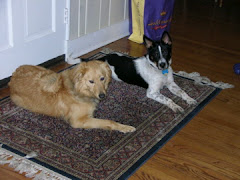Jake is staying with us for a few days while Debs is traveling for work. Overall Jake is a very fine houseguest. He has stayed here many times so we have established a routine at our house. Nevertheless, since we all have different routines, I have been reflecting on how animal companions can best prepare both the dog and their temporary doggie caregivers for their time together. (Please note, none of these tips are meant to suggest that I don’t have the information I need to take care of Jake!)
Some of the things below may seem obvious, but that’s why it’s important to remember them. You have adapted to your little treasure’s quirks, but many of them will be new to the temporary caregiver. Covering as many bases as possible ahead of time will make the temporary experience more pleasant for all.
First, make sure your dog is comfortable with the person who will be taking care of them, and anyone else in the house (animals or people!). Your dog should be up-to-date on all vaccinations. Provide emergency contact information, especially vet information. If you are going to be unreachable, write a letter authorizing the caregiver to seek emergency treatment for your dog.
Day to day stuff
1. Are there special dietary needs: times to eat, allergies, etc.? If available, is the ‘house dog chow’ acceptable? Needless to say, if the dog requires special food, you should provide it.
2. Is there a fixed or flexible walking schedule? If there are any idiosyncrasies related to the dog taking care of its business, let us know! How long can the dog last without having to go outside?
3. If your dog needs pills or vitamins, not only do you need to let us know how much how often, but it’s also a good idea to advise the caregiver on effective strategies to get the dog to eat/swallow them. Some dogs will let you shove pills down their throat, others have to eat them themselves so the pills have to be effectively disguised and administered.
4. Tell the caregiver the basic commands your dog understands. For example, Phoebe drops the ball to “drop it” while Jake (sometimes) drops the ball to “give.”
5. Let us know if the dog has any unusual “triggers.” Whenever someone else is taking Phoebe for a walk, I tell them to hold on tight to the leash because she is prone to want to chase after all manner of moving vehicles.
6. What about bedtime? Does the dog sleep in the bedroom (or expect a spot on the bed?), a crate, another part of the house, on their own special bed? When I was a kid, our dog slept in the laundry room. Phoebe sleeps in the bedroom, but not on the bed.
7. Is there anything else I should know? Does the dog dig or jump fences? This is important if it is going to spend time in a yard. Does the dog like toddlers? This is important if there are little kids around. When you go on a walk are there certain types of people or animals the dog doesn’t like – children? men? rowdy teenagers? other dogs? Does the dog scratch or chew on the furniture, wires, walls, or doors if it is left in the house by itself?
I’m sure this doesn’t cover everything, but the list should get you thinking about the kind of information you should provide to anyone who might be taking care of your favorite canine companion.
Thursday, March 6, 2008
My bags are packed, I'm ready to go
Posted by
Wags
at
Thursday, March 06, 2008
![]()
![]()
Labels: dog care, dog sitting
Subscribe to:
Post Comments (Atom)


No comments:
Post a Comment